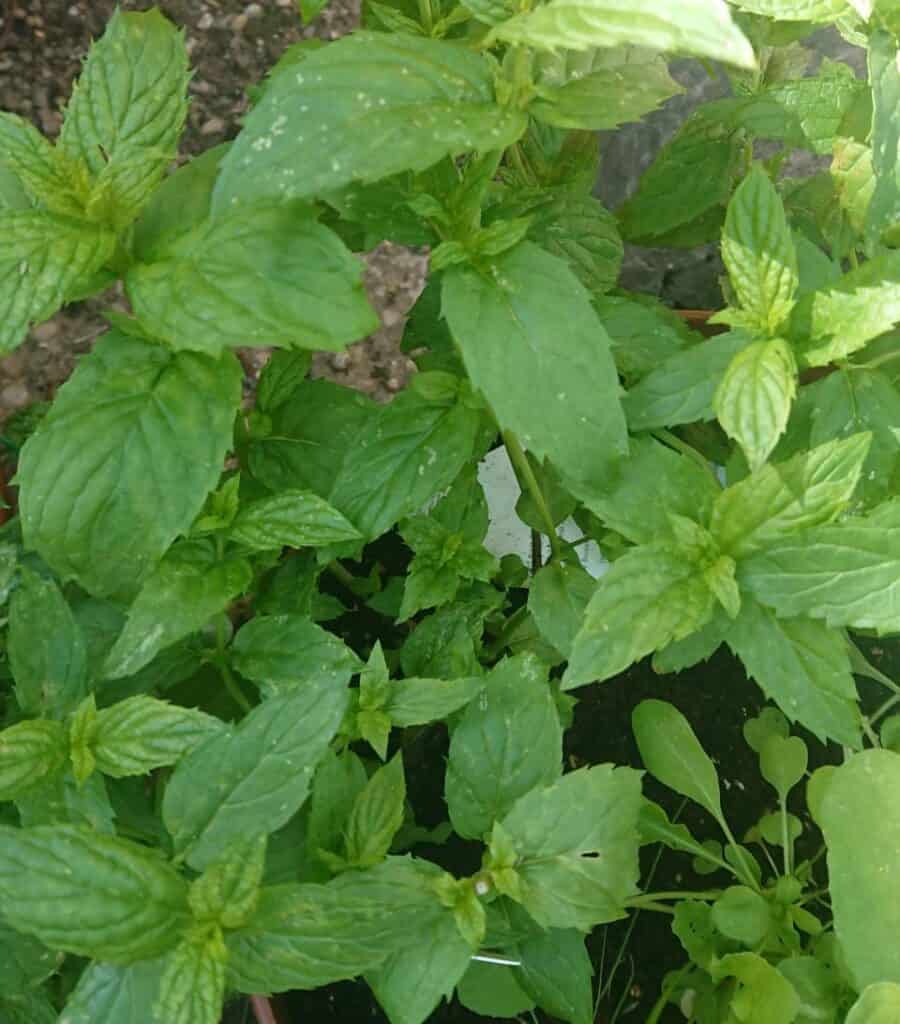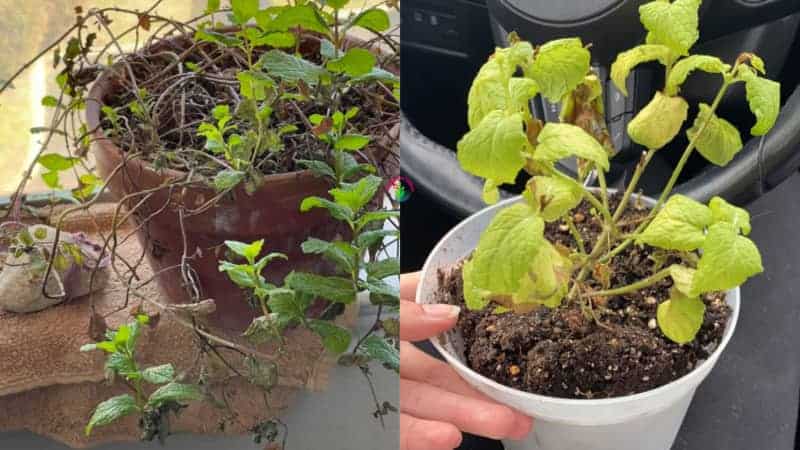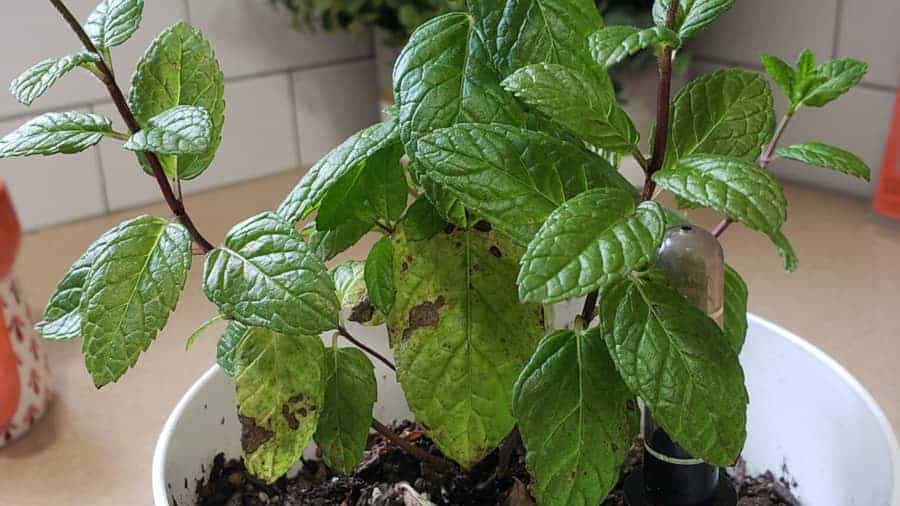Mint is a hardy perennial herb that grows well in damp compost and full sunlight. However, if the soil dries up, they are prone to withering.
In sandy soils or from inadequate watering, mint plants typically wilt due to a lack of moisture in the soil. To keep the soil continuously moist and to stop the mint from wilting or drooping, water it as often as necessary.
On hot days, mint may also briefly wilt before rebounding in the evening when it is cooler.
The most likely causes of mint wilting are likely to be underwatering or swiftly draining soils, but there are a few additional potential causes, which I’ve listed below in decreasing order of likelihood:
- soils that dry out quickly or are underwatering.
- Due to the limited pot size or a lack of drainage holes in the base, potted mint is wilting.
- soil that is too wet, leading to root rot.
- Mint shock caused by withering after planting.
- Mint that is lanky from a lack of sunlight, excessive fertilizer, or infrequent pruning.
Read on to learn how to put these fixes into practice and keep your dying mint alive.
Table of Contents
Mint Wilting due to Under Watering
Underwatering is by far the most frequent reason for mint wilting.
Mint needs continually moist soil and regularly wilts if the soil becomes dry, thus it needs to be watered frequently.
There are various factors to consider in order to prevent mint from wilting from inadequate moisture or watering. Which are:
- Compost. Rich loam soil or compost are preferred for mint over poor sandy soil because they hold moisture.
- containers and pots. On warmer days, if the pot or container is too tiny, it may dry out quickly.
- weather and the climate. The only time mint needs water is during the hottest weeks of the year in some temperate locations with considerable rainfall. However, planted mint may need watering every other day in warmer conditions.
How to Save an Under Watered Mint
Adjusting the frequency of watering to maintain continuously wet soil to meet the conditions of your garden is the key to preventing mint from drooping due to dehydration.
A weekly watering may be sufficient to keep the soil’s moisture and prevent wilting in mild temperate areas, but it may be appropriate to water mint every other day in summer in more arid climates like California or the Mediterranean.
Therefore, if your mint plant is wilting because the soil is dry, generously wet it. In pots, this refers to soaking the soil until water can be seen dripping from the base, ensuring that the soil is moist throughout.
Give mint a good watering in the garden borders and then cover it with mulch to help it retain moisture and lessen evaporation on hot days.
Compost, leaf mold, and well-rotted manure are excellent choices since they have a great capacity to hold moisture, add nutrients to the soil, and enhance the general texture of the soil.
The mint should recover in a few days if you plant it in a lot of compost to help it retain moisture and water it as much as necessary to keep the soil moist but not saturated.
Remember that mint can briefly wilt in intense heat before recovering to normal in the colder evening hours.
(Read how to water mint plants in my article.)
Potted Mint Wilting
- The pot is too small and dries soon in the sun.
- The pot doesn’t have any drainage holes (or excess water is trapped due to a drip tray or the use of a decorative pot).
Smaller pots are unable to hold as much moisture since they have less soil holding capacity.
This is complicated by the fact that mint appreciate full sun (and tolerate moderate shade) (and tolerate partial shade). In direct sunlight, a smaller pot heats up considerably more fast than a larger one, and the soil’s moisture evaporates much more quickly.
Certain pots, including those made of metal or dark plastic, readily transfer heat, which exacerbates the drying effects of the sun.
Due to a lack of water, all of this causes the soil to be too dry for mint, causing it to wilt or droop.
If the mint’s pot or container lacks drainage holes in the base, the opposite may be true.
Without adequate drainage, extra water collects in the container, causing the soil to become permanently soggy rather than simply moist.
The conditions for fungal illnesses and root rot are encouraged by this soggy soil, which can make the mint wilt and turn yellow or brown.
How to Save Mint Wilting in Pots
Repotting mint plants into a larger pot will help them recover from wilting caused by a tiny pot. Select a pot that:
- 12 inches or more across.
- For optimal results, plant mint in terracotta, clay, or ceramic pots.
The soil in a pot that is at least 12 inches across can hold enough moisture for a longer time.
The larger pot with more soil and moisture will keep the plant healthy and hydrated between waterings because mint plants need continuously moist soil to prevent wilting.
Depending on your climate and weather, water the mint as often as necessary to keep the soil moist, and it should recover from its wilted or droopy appearance.
In comparison to plastic or metal pots, clay, terracotta, and ceramic pots take longer to heat up, keeping the soil cold and moist during hot weather.
Repotting mint into a container with drainage holes in the base will let excess water to drain and stop it from wilting due to soggy soil in pots without drainage holes.
Using a saucer or drip tray to capture extra water from the pot that could drip onto furniture is a common problem when growing mint indoors.
The mint will suffer from root rot if you don’t bring the pot of mint back inside after watering it outside for 30 minutes. Instead, place a paper towel under the plant to absorb any extra moisture and safeguard your indoor furnishings.
When the mint is put in a suitable pot with sufficient drainage, it should revivify.
If there is any yellow foliage, remove it with sterile pruners and disinfect the blades with alcohol after each cut to avoid the risk of spreading fungi.
If the mint plant is noticeably yellow and drooping and shows no signs of recovery after a few weeks, it can be worthwhile to replace the plant because root rot in mint roots can be prevented rather than treated.
Mint Wilting due to Saturated Soil
Slow-draining or soggy soils can cause mint to wilt by fostering the conditions for root rot and other fungal disease infections like Verticillium dahliae.
Due to slow-draining soils, root rot and fungal disease signs include:
- a look of withering or drooping.
- leaves that are yellowing.
- roots that appear soft and rotting and have turned a dark brown color.
When mint plants are planted in rich compost, root rot is less likely to happen because the compost’s porous nature allows excess water to drain away rather than remain soggy and saturated.
The most frequent culprits for root rot are pots without adequate drainage holes, low lying sections of the garden where water naturally accumulates, and slow draining soils like clay.
How to Save a Wilting Mint in Boggy Soil
It can be challenging to salvage mint plants that are withering as a result of root rot, and when it comes to root rot, prevention is always preferable to cure.
Plant the mint in well-draining, multipurpose compost to prevent root rot, and you shouldn’t experience any issues unless the ground is soggy due to other factors, like heavy clay.
The best approach to grow mint in gardens with clay soil or soggy ground is in pots, containers, and raised beds.
Instead of having to modify garden soil, pots and containers have good drainage and allow you to regulate the soil profile much more easily.
Root rot has caused a mint plant to wilt, so it’s critical to:
- Mint should be removed from the soggy region and transplanted into a pot with multipurpose compost.
- When you pull the mint from the soil check the roots. With a sterile set of pruners, cut the diseased roots back to healthy growth if they appear dark brown and diseased rather than healthy and light in color.
- After each cut, clean the pruner blades with a cloth dipped in alcohol disinfectant to avoid the risk of transferring fungi from sick roots to healthy ones.
- In a pot with multipurpose compost, plant the mint, and position the pot in direct sunlight.
Whether the mint heals depends on the severity of the root rot. It is advisable to purchase additional mint (or grow from seed) to grow in a container if the majority of the leaves is yellow and wilted with few good roots.
However, if the damage from root rot is restricted to a few roots and the plant recovers after about two weeks, mint can recover.
Mint Wilting After Planting (Transplant Shock)
Transplant shock can cause mint plants to wilt or droop.
When you purchase mint from a supermarket or garden center, it has typically been grown in a temperature-controlled greenhouse, where the plant has adapted to a certain amount of light, watering, and soil nutrients.
Even if you give the plant ideal growing circumstances, mint that you purchase and put in your garden may briefly wilt due to transplant shock.
Because the mint was grown under different conditions than your garden soil or pot, this is merely a sign of stress.
Do not panic as mint is a robust, resilient herb that comes back with vengeance!
How to Save Mint with Transplant Shock
Watering the mint well after planting is the most crucial step in preventing transplant shock. Mint grows best in constantly moist soil, so reduce how often you water it to prevent the soil from drying up.
Make sure the compost is rich before planting the mint. When your mint plants are potted up, using proper compost will pay off and keep them from withering. The compost should be porous, friable, and retain moisture.
Mint does not do well in sandy or stony soils that drain fast, thus the more compost you add to the planting area, the better the mint plant will grow.
Place the mint plant in full sun and plant it in a pot that is large enough for the roots to grow properly.
Give mint the right environment for growth, and it should recover from transplant shock within a week. Regular watering is also essential to maintain the soil moist and prevent wilting of the mint.
Wilting or Leggy Mint (Not Enough Sun or Pruning)
- Regular trimming of the mint has not been done.
- lack of sunlight (mint prefers full sun or partial shade).
- nitrogen fertilizer in excess.
Mint plants can become lanky, less prolific, and occasionally droop under their own weight if they are not regularly pruned throughout the spring and summer.
Regular pruning of mint plants promotes the development of new leaves, prevents flowering (which prevents mint from going to seed and becoming less productive), and keeps the plant looking tidy rather than lanky and drooping.
It promotes the plant to expand excessively in search of additional light, which results in a drooping or wilted appearance if the mint is in excessive shade.
As the softer growth cannot hold its own weight, too much nitrogen fertilizer can also stimulate large foliage growth and weaken the stems, causing the mint to droop or wilt.
How to Save Leggy Mint
Make careful to routinely clip the plant to maintain its health if you want to save lanky, drooping mint. Throughout the growing season, you can prune mint whenever you’d like to utilize it in your cuisine or a mojito!
Cut back the mint to a few inches. Pruning back to around 4 inches or so keeps the mint from producing leaves with a poor flavor and aroma. Fortunately, mint is such a resilient plant that it can endure rigorous pruning and come back stronger.
Watch this useful YouTube video for a visual guide to pruning mint:
With a few hours of sun in the morning or afternoon, mint plants may thrive in both full sun and partial shade. However, it struggles to develop in complete darkness, which makes the mint wilt or droop as it looks for light.
The remedy is to simply relocate the pot to an area with more sun if the mint is planted in a pot, which is the best technique to grow mint because of its propensity to spread along garden fences. If you trim the mint’s lanky growth back to about 4 inches, it should recover rapidly.
Mint plants can benefit from fertilizers, especially if they are growing in containers or poor soil with little access to nutrients (however mint can grow well without fertilizer if the soil is nutrient rich).
The stems may droop if you fertilize too frequently or with an excessive amount of fertilizer. Reduce the amount of fertilization you do throughout the growing season to once every 4-6 weeks, and trim back any overgrown growth that is drooping.
If your mint has been wilting, use a water-soluble all-purpose fertilizer and think about using half strength for any additional applications.
The mint should recover and grow healthily as long as it receives full or partial sun and the soil is regularly moist.
Key Takeaways:
- Mint typically wilts owing to dehydration brought on by dry soil that drains too quickly or inadequate watering. Mint likes consistently moist soil because dry dirt can cause the leaves to droop.
- To keep the soil continuously moist, water the mint as often as necessary. Throughout order to prevent wilting, potted mints frequently need additional water, so give them a nice soak once every few days in the summer.
- Mint can droop as a sign of root rot, which is brought on by soggy or damp soil. Mint with root rot appears to be wilting and its leaves may turn yellow under stress. To prevent root rot, plant mint in containers in gardens with slow-draining soil.
- Due of the difference in temperatures and environmental factors between the greenhouse where it was grown and your garden, mint can momentarily wilt as a result of transplant shock. Mint should recover if planted in full light and given frequent watering.
- Mint plants can become lanky owing to a lack of sunlight, too much fertilizer or a lack of frequent pruning.
- Because the soil can become wet and the pot becomes too small or lacks drainage holes in the base, potted mint may wilt. Mint should be grown in containers with drainage holes in the base and at least a 12-inch diameter.
FAQ
Why is my potted mint plant dying?
A dying mint plant is typically caused by inadequate watering or by mint being put in a pot with insufficient moisture and nutrients. Dry soil and inadequate irrigation are likely to blame for your mint’s wilting and browning.
How do you revive wilted mint plants?
A big bowl should be filled with ice and cold water. After removing any damaged or charred leaves, place the entire bundle of wilted herbs in the ice bath. The herbs will be revived by the cold water. It might take about 15 minutes or up to an hour, depending on the herb and how wilted it is.
How do you bring a mint plant back to life?
Can you overwater a mint plant?
Many things occur when a mint plant is overwatered over an extended period of time. Long-term overwatering of mint plants causes their roots to rot, which causes the plant to grow slowly until all of the roots are entirely rotted.
How often should you water mint?
Once or twice every day



